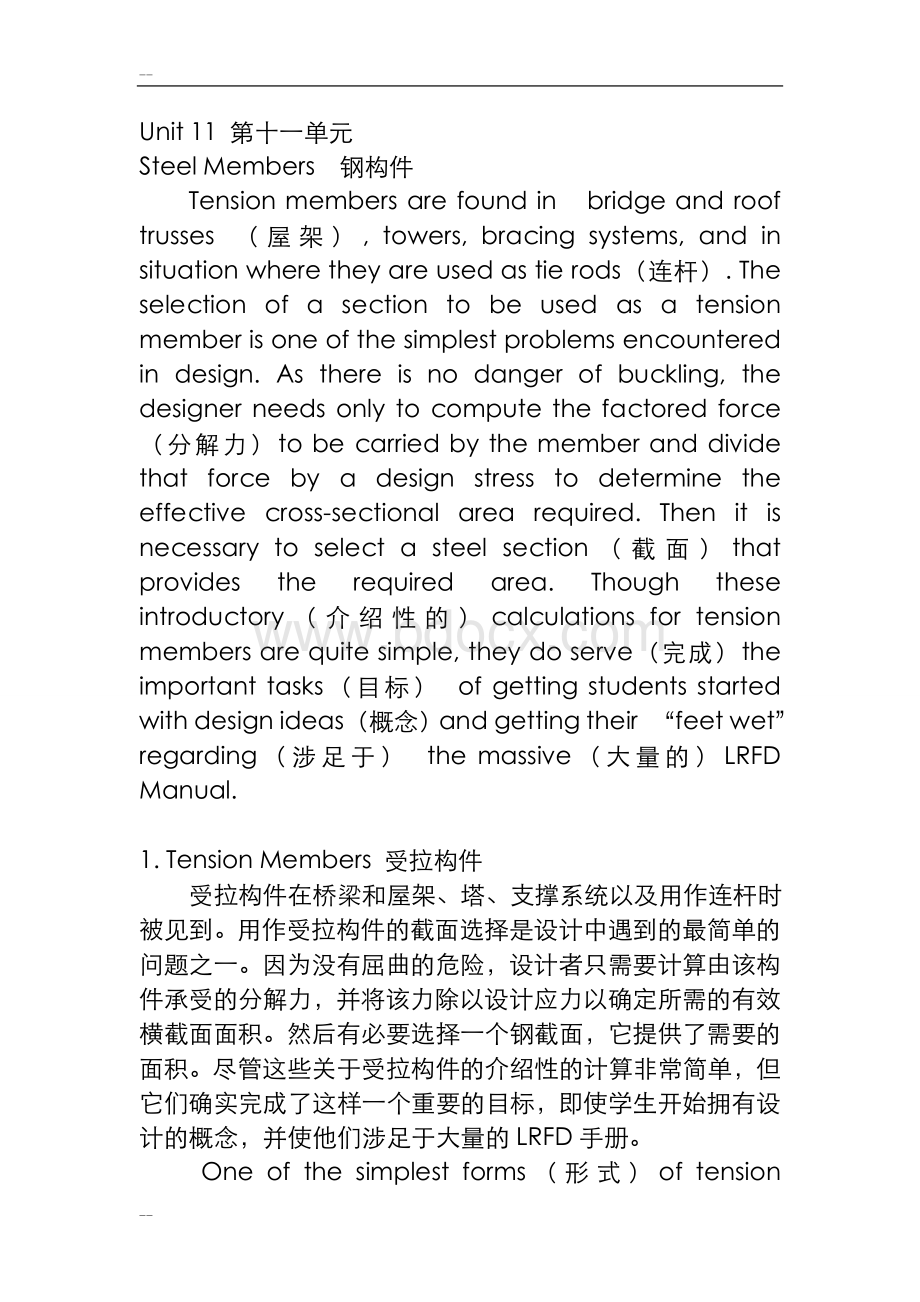 土木工程专业英语(苏小卒)课文翻译11、13、15、17单元Word下载.doc
土木工程专业英语(苏小卒)课文翻译11、13、15、17单元Word下载.doc
- 文档编号:13198582
- 上传时间:2022-10-08
- 格式:DOC
- 页数:46
- 大小:126.50KB
土木工程专业英语(苏小卒)课文翻译11、13、15、17单元Word下载.doc
《土木工程专业英语(苏小卒)课文翻译11、13、15、17单元Word下载.doc》由会员分享,可在线阅读,更多相关《土木工程专业英语(苏小卒)课文翻译11、13、15、17单元Word下载.doc(46页珍藏版)》请在冰豆网上搜索。

1.TensionMembers受拉构件
受拉构件在桥梁和屋架、塔、支撑系统以及用作连杆时被见到。
用作受拉构件的截面选择是设计中遇到的最简单的问题之一。
因为没有屈曲的危险,设计者只需要计算由该构件承受的分解力,并将该力除以设计应力以确定所需的有效横截面面积。
然后有必要选择一个钢截面,它提供了需要的面积。
尽管这些关于受拉构件的介绍性的计算非常简单,但它们确实完成了这样一个重要的目标,即使学生开始拥有设计的概念,并使他们涉足于大量的LRFD手册。
Oneofthesimplestforms(形式)oftensionmembersisthecircularrod(圆钢),butthereissomedifficultyinconnectingittomanystructures.Therodhasbeenusedfrequentlyinthepast,buthasonlyoccasionalusestodayinbracingsystems,lighttrusses,andintimberconstruction.Oneimportantreasonrodsarenotpopularwith(受..欢迎)designersisthattheyhavebeenusedimproperly(不恰当地)soofteninthepastthattheyhaveabadname(落得坏名声);
however,ifdesignedandinstalledcorrectly,theyaresatisfactoryformanysituations.
受拉构件最简单的形式之一是圆钢,但是将其与很多结构连接有一些困难。
过去常常采用圆钢,但是如今只偶然用于支撑系统、轻质桁架以及木结构。
圆钢不受设计者欢迎的一个重要原因是过去常常被不恰当地使用,以至于落得坏名声;
但是如果正确地设计和安装,它们在很多情况下是令人满意的。
Theaverage(通常)sizerodhasverylittle(几乎没有)stiffnessandmayquiteeasilysag(下垂)underitsownweight(自重),injuring(破坏)theappearanceofthestructure.Thethreadedrodsformerlyusedinbridgesoftenworkedloose(松掉)andrattled(发出嘎嘎声).Anotherdisadvantageofrodsisthedifficultyoffabricatingthemwiththeexactlengthsrequiredandtheconsequent(随之发生的)difficultiesofinstallation.
通常尺寸的圆钢几乎没有刚度,并且在自重下很容易下垂,因而破坏了结构的外观。
以前用于桥梁的有螺纹的圆钢常常松掉,并发出嘎嘎声。
圆钢的另一个缺点是难以按需要的精确长度来制作,随之发生的是安装的困难。
Whenrodsareusedinwindbracing(抗风支撑)itisagoodpractice(作法)toproduceinitialtension(初张力)inthem,asthiswilltightenup(拉紧)thestructureandreducerattlingandswaying.Toobtaininitialtensionthemembermaybedetailed(设计)shorterthantheirrequiredlengths,amethodthatgivesthesteelfabricatorverylittletrouble.Acommonruleofthumb(单凭经验的方法)usedistodetailtherodsabout1/16in.shortforeach20ft.oflength.(Approximatestressf=εE=[1/16(12)(20)](29×
106)=7550psi.)Anotherverysatisfactorymethodinvolvestighteningtherodswithsomesortofsleevenut(套筒螺母)orturnbuckle(套筒螺母).Part8oftheLRFDManualprovidesdetailedinformationforthesedevices(方法).
当圆钢被用作抗风支撑时,一个很好的做法是使它们产生初张力,因为这将拉紧结构,并减少发出嘎嘎声和摇晃。
为获得初张力,杆件可以设计得比它们需要的长度短,该法对钢材的制作者来说几乎没什么麻烦。
一个常用的经验法是设计该圆钢时每20英尺的长度缩短约1/16英寸。
(近似应力f=εE=[1/16(12)(20)](29×
106)=7550psi.)另一个非常令人满意的方法包括采用某种套筒螺母拉紧圆钢。
LRFD手册的第八部分提供了有关这些方法的详细信息。
Theprecedingdiscussiononrodsshouldillustratewhyrolledshapes(轧制型钢)suchasangleshavesupplanted(代替)rodsformostapplications.Intheearlydaysofsteelstructures,tensionmembersconsistedofrods,bars(型钢),andperhapscables(索).Today,althoughtheuseofcablesisincreasingforsuspended-roof(悬索屋顶)structures,tensionmembersusuallyconsistofsingle(单)angles,double(双)angles,tees(T形钢),channels(槽钢),Wsections(型钢),orsectionsbuiltupfromplates(薄钢板)orrolledshapes.Thesememberslookbetterthantheoldones,arestiffer,andareeasiertoconnect.Anothertypeoftensionsection(构件)oftenusedistheweldedtensionplateorflatbar(扁钢),whichisverysatisfactoryforuseintransmissiontowers(发射塔),signs(广告牌),footbridges(人行桥),andsimilarstructures.
前面关于圆钢的讨论应该阐明为什么诸如角钢的轧制型钢已在多数应用中代替了圆钢。
在早期的钢结构中,受拉构件包括圆钢、型钢以及可能是索。
今天尽管索在悬索屋顶结构中的使用不断增加,受拉构件通常包括单角钢、双角钢、T形钢、槽钢、W型钢,或由薄钢板或轧制型钢组合成的型钢。
这些构件看上去比老的更好、更结实、更容易连接。
另一种常用的受拉构件是焊接的受拉薄钢板或者是扁钢,它在用于发射塔、广告牌、人行桥以及类似的结构中是非常令人满意的。
Thetensionmembersofsteelrooftrussesmayconsistofsingleanglesassmallas21/2×
2×
1/4forminormembers.Amoresatisfactorymemberismadefromtwoanglesplacedbacktoback(背对背)withsufficientspacebetweenthemtopermittheinsertionofplates(金属板)(calledgussetplates节点板)forconnectionpurposes.Wheresteelsections(型钢)areusedback-to-backinthismanner,theyshouldbeconnectedevery(每隔)4or5ft.topreventrattling,particularlyinbridgetrusses.Singleanglesanddoubleanglesareprobablythemostcommontypesoftensionmembersinuse.Structuralteesmakeverysatisfactorychordmembers(弦杆)forweldedtrussesbecausewebmembers(腹杆)canconvenientlybeconnectedtothem.
钢屋架的受拉构件由单角钢组成,对次要构件其尺寸可小至21/2×
1/4。
一种较满意的构件是由两根
- 配套讲稿:
如PPT文件的首页显示word图标,表示该PPT已包含配套word讲稿。双击word图标可打开word文档。
- 特殊限制:
部分文档作品中含有的国旗、国徽等图片,仅作为作品整体效果示例展示,禁止商用。设计者仅对作品中独创性部分享有著作权。
- 关 键 词:
- 土木工程 专业 英语 小卒 课文 翻译 11 13 15 17 单元
 冰豆网所有资源均是用户自行上传分享,仅供网友学习交流,未经上传用户书面授权,请勿作他用。
冰豆网所有资源均是用户自行上传分享,仅供网友学习交流,未经上传用户书面授权,请勿作他用。


 (完整word版)信息论与编码期末考试题----学生复习用.doc
(完整word版)信息论与编码期末考试题----学生复习用.doc
 (完整版)固定资产盘点表.xls
(完整版)固定资产盘点表.xls
